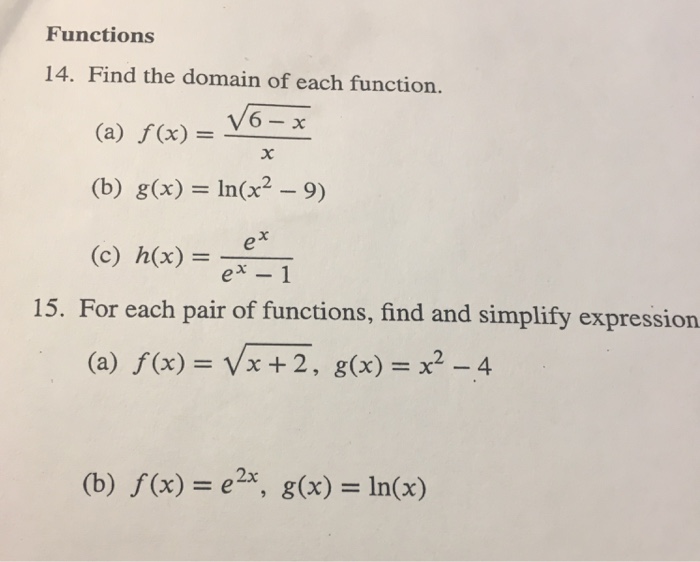So you just set the inside of ln to equal zero, and see what values of x are allowed, in this case x>5, since all the values below it are negative or zero. Domain and range » tips for entering queries.

Finding The Domain Of Logarithmic Functions - Youtube
The domain calculator allows you to take a simple or complex function and find the domain in both interval and set notation instantly.

Finding domain of ln functions. The value of h of 3 causes the “standard” function and its asymptote to move to the right by 3 units. Exchange x with y and finding y): Thanks to all of you who s.
Join / login >> class 11 class 11 >> applied mathematics applied mathematics >> functions See if you have ln (x), then x>0, since it can't be zero and x cannot be negative. Then the domain of a function is the set of all possible values of x for which f(x) is.
Asking for help, clarification, or responding to other answers. The inverse function of the logarithmic function is the exponential function. Let us draw the graph of this.
The function is defined for only positive real numbers. Find the domain and range of the function y = log ( x ) − 3. D=(6,+oo) the range of a function is the domain of the inverse function.
Graph the function on a coordinate plane.remember that when no base is shown, the base is understood to be 10. So (using the method to find the inverse function, that is: P(x)=\ln(x) has range all reals.
Thanks for contributing an answer to mathematics stack exchange! Please subscribe here, thank you!!! First, we learn what is the domain before learning how to find the domain of a function algebraically.
👉 what is the domain of a function?. This changes the domain of the function. Multiplying both sides of the inequality by x 2 gives x 2 − x > 0.
Click the blue arrow to submit and see the result! For ln ( 1 − 1 x), we require 1 − 1 x > 0. Sgn ( ln ( x 2 − x + 2)) = 1.
Given a function of natural logarithms, how do i find the range? To find the domain of a vector function, we’ll need to find the domain of the individual components a, b and c. The solution to this inequality is x > 1 or x < 0.
Please be sure to answer the question.provide details and share your research! High school math homework help university math homework help academic & career guidance general mathematics search forums Okay so i am taking calculus 1 and thought i fully understood how to find the domain of functions until i saw one with a natural log on the top.
Domain of a function calculator. 3 < x < ∞. Sgn ( ln ( x 2 − x + 2)) will always be 1.
The range of the function never changes so it remains: The graph is nothing but the graph y = log ( x ) translated 3 units down. To avoid ambiguous queries, make sure to use parentheses where necessary.
Then the domain of the vector function is the values for which the domains of a, b, and c overlap. Thanks to all of you who support me on patreon. − ∞ < x < ∞.
A function is expressed as. These lead to reducing ranges by removing values the function is allowed to compute. Domain of ln ( y):
Find the domain and range of f ( x) = log ( x − 3). To work out the domain you need to know what values of x are allowed and not allowed. Y=f(x), where x is the independent variable and y is the dependent variable.
Enter the function you want to domain into the editor. How would i find the domain and range of the functions. Any help would be appreciated, thanks.
The domain for the log function is ( 0, ∞). The domain of a function f (x) is the set of all values for which the function is defined or in other words, we can say. Here are some examples illustrating how to ask for the domain and range.
The above equation means that for any values of x, the function. From the graph, we can find the domain and range. Enter your queries using plain english.
I have a test tomorrow and i know how to graph these functions but i just need to know how to find the domain and range. I’d check for any explicit domain restrictions;

3.2 Logarithmic Functions And Their Graphs Students Will Recognize And Evaluate Logarithmic Functions With Base A. Students Will Graph Logarithmic Functions. - Ppt Download

Find The Domain Of The Multivariable Function F(X, Y) = X/Ln(Y) | Math Videos, F(X), Domain